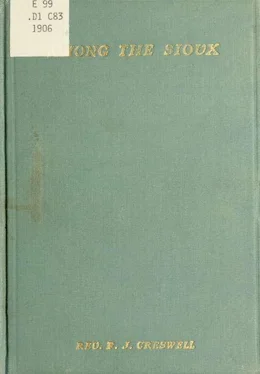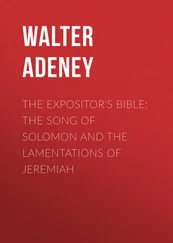Creswell, J.) - Among the Sioux - a story of the Twin Cities and the two Dakotas
Здесь есть возможность читать онлайн «Creswell, J.) - Among the Sioux - a story of the Twin Cities and the two Dakotas» весь текст электронной книги совершенно бесплатно (целиком полную версию без сокращений). В некоторых случаях можно слушать аудио, скачать через торрент в формате fb2 и присутствует краткое содержание. Жанр: Старинная литература, на английском языке. Описание произведения, (предисловие) а так же отзывы посетителей доступны на портале библиотеки ЛибКат.
- Название:Among the Sioux : a story of the Twin Cities and the two Dakotas
- Автор:
- Жанр:
- Год:неизвестен
- ISBN:нет данных
- Рейтинг книги:5 / 5. Голосов: 1
-
Избранное:Добавить в избранное
- Отзывы:
-
Ваша оценка:
- 100
- 1
- 2
- 3
- 4
- 5
Among the Sioux : a story of the Twin Cities and the two Dakotas: краткое содержание, описание и аннотация
Предлагаем к чтению аннотацию, описание, краткое содержание или предисловие (зависит от того, что написал сам автор книги «Among the Sioux : a story of the Twin Cities and the two Dakotas»). Если вы не нашли необходимую информацию о книге — напишите в комментариях, мы постараемся отыскать её.
Among the Sioux : a story of the Twin Cities and the two Dakotas — читать онлайн бесплатно полную книгу (весь текст) целиком
Ниже представлен текст книги, разбитый по страницам. Система сохранения места последней прочитанной страницы, позволяет с удобством читать онлайн бесплатно книгу «Among the Sioux : a story of the Twin Cities and the two Dakotas», без необходимости каждый раз заново искать на чём Вы остановились. Поставьте закладку, и сможете в любой момент перейти на страницу, на которой закончили чтение.
Интервал:
Закладка:
"Ye Christian heralds, go proclaim
Salvation through Emmanuel's name;
To distant lands the tidings bear
And plant the Rose of Sharon there." And now a lively young lass, neatly attired, comes forward and with a fine, clear accent, recites a poem 01 hope, touching the bright future of their tribe, when tbe present generation of young men and maidens, nourished in Christian homes, educated in Christian schools and trained in the Young People's societies for efficient service, shall control their tribe, and move the great masses of their people upward and God-ward, and elevate the Sioux Nation to a lofty plane of Christian civilization and culture; and enable them to display to the world the rich fruition of Christian service. And, by request, their voices ring out in song these thrilling words;
aC among the SIOUX.
"Watchman, tell us of the night, For the morning seems to dawn; Traveller, darkness takes its flight, Doubt and terror are withdrawn. Watchman, let thy wanderings cease; Hie thee, to thy quiet home; Traveller, lo, the Prince of Peace, Lo, the Son of God is come!"
Fervent prayers are frequently interspersed in these exercises. And oh, what wondrous liberality these dark-skinned sisters of the Dakota plains display!
How full their hands are with rich gifts, gleaned out of their poverty for the treasury of their Saviour-ving. For many years, the average annual contribu-icns per capita to missoins, by these Sioux sisters, nave fully measured up to the standard of tlieir more lighly favored Anglo-Saxon sisters of the wealthy Presbyterian and Congregational denominations,of which they form a humble part.
Chapter VI.
It was 1905. From the heights of Sisseton, South Dakota, another striking scene met the eye. The great triajigiilar Sisseton reserve of one million acres no longer exists. Three hundred thousand of its choicest acres are now held in severalty by the fifteen hundred members of the Sisseton and Wahpetou Band of the Dakotas—the '"Leaf Dwellers" of the plains. Their homes, their schools, their churches cover the prairies. That spire pointing heavenward rises from Good Will Church, a commodious, well-furnished edifice, with windows of stained glass. Within its walls, there worship on the Sabbath, scores of dusky Presbyterian Christians. The pastor, the Rev. Charles Crawford, in whose veins there flows the mingled blood of the shrewd Scotch fur trader and the savage Sioux, lives in that comfortable farm house a few rods distant. He has a pastorate that many a white minister might covet. Miles to the west, still stands in its grassy cove on the coteaux of the prairie, the Church of the Ascension, referring not to the ascension of our Lord, but to "the going up" of the prairies. On the hill a-bovc it, is the cozy home of the pastor emeritus, the the Rev. John Raptiste Renville, whose pastorate, in point of continuous service, has been the longest in the two Dakotas. After a long lifetime of faithful ministrations to the people of his own charge, enfeebled by age and disease, he sweetly fell asleep in Jesus, Dec.
19, 1904. Doubtless his is a starry crown, richly gemmed, in token of the multitude of the souls of his fellow tribesmen, led to the Savior by his tender, faithful ministry of a life-time in their midst. Round about these two churches cluster half a dozen other congregations, worshipping in comfortable church homes. These form only a part of the
PRESBYTERY OF DAKOTA.
The original Presbytery of Dakota was organized September 30, 1844, at the mission Home of Dr. Williamson, at L.ac-qui-Parle, Minnesota. It was organized, by the missionaries, among the Dakotas, for the furtherance of their peculiar work. The charter members were three ministers, the Rev. Samuel W. Pond, Rev. Thomas S. Williamson, M.D., and Rev. Stephen R. Riggs and one elder Alexander G. Huggins. It was an independent presbytery, and, for fourteen years, was not connected wdth any Synod. It was a lone presbytery, in a vast region, now covered by a dozen Synods and scores of presbyteries. For many years, the white and Indian churches that were organized in Minnesota, were united in this presbytery and wrought harmoniously together. In 1858, the General Assembly of Presbyterian churches (N. S.) invited this independent presbytery to unite with her two Minnesota Presbyteries and form the Synod of Minnesota which was accomplished.
Solely on account of the barrier of the language, the missionaries and churches among the Dakotas, petitioned the Synod of Minnesota to organize them into a separate presbytery. And the Synod so ordered and
it was so done, September 30, 1867, just twenty three years after the first organization at Lac-qui-Parle. By this order, the limits of the Presbytery of Dakota became the churches and ministers among* the Dakota Indians. It is the only Presbytery in existence, without any geographical boundaries. At present, there are seventeen ordained Indian ministers upon the roll of this presbytery—workmen of whom neither they themselves nor any others have any cause to be ashamed. There are, also, under its care, twenty-eig'ht well-organized churches, aggregating more than fifteen hundred commtmicants, and eight hundred Sabbath-School members. The contributions of these fifteen hundred Dakota Presbyterians in 1904, exceedied the sum of six thousand dollars for all religious purposes.
Among the "Dispersed" of the Sioux nation, in Manitoba, there is one organized Presbyterian church of twenty-five communicant members. It is the church of Beulah and is in connection with the Presbyterian church of Canada.
In all, twenty-one Sioux Indians have been ordained to the Presbyterian ministry, by the Presbytery of Dakota. Of these. Artemas Ehnamane, Titus Icaduze, Joseph Iron Door, and John Baptiste Renville have all passed on, from the beautiful prairies of the Dakotas, to the celestial plains of glory. And how warm must have been their greeting as they passed through the pearly gates of the city, whose builder and maker is God. Gideon Pond, Dr. Williamson, Samuel W. Pond, Stephen R. Riggs and Robert Hopkins, Margaret Williamson, Mary Riggs and Aunt Jane and Qth-
er faithful missionaries and thousands of redeemed Da-kotas,' welcomed them, with glad hozannas, and sweet are the songs they sing as the}- walk together, under the trees, on the banks of the River of Life.
The Dakota Congregational association has under its care thirteen organized churches, with more than one thousand communicants and one thousand Sabbath school members. The prominent leaders of its work are Alfred L. Riggs D.D., of Santee, Nebraska, and Rev. Thomas L. Riggs of Oahe, South Dakota. They arc the worthy sous of their famous father, Stephen R. Riggs, D.D., one of the heroic pioneers in the Dakota work. The native ministers are Francis Frazier, Edwin Phelps, James Garvie, James Wakutamani and Elias Gilbert. This association is a mig'hty factor in God's plan, for the upbuilding of the Dakotas, in the things that are noble and of good report.
The Presbyterian and Congregationalists have wrought together, side by side, for seventy years, in this glorious enterprise. Under their auspices, forty-four churches, many schools and other beneficent organizations are in efficient operation among these former savage dwellers on these plains.
Seven other natives have, also, been ordained to the priesthood in the Episcopal Church, making thirty-three in all, who have served their fellow-tribesmen in the high and holy office of the Christian ministry. There is not a single ordained Romish priest among the Sioux Indians.
'AVatchman, tell us of the night. What its signs of promise are."
Seventy years ago, among the twenty-five thousand Sioux Indians in the United States, there was not a single churcli. not even one professing Christian.
They were all polytheistic pagans. There were signs of pagan worship about every teepee. It might be the medicine sack tied behind the conical wigwam, or a yard of broadcloth, floating from the top of a flagpole as a sacrifice to some deity. There was more or less idol-worship in all their gatherings. One of the simplest forms was the holding of a well-filled pipe at arm's length, with the mouth-piece upward, while the performers said, "O Lord, take a smoke and have mercy on me." In the feasts and dances, the forms were more elaborate. The Sun-dance continued for days of fasting and sacrificial work by the participants.
Читать дальшеИнтервал:
Закладка:
Похожие книги на «Among the Sioux : a story of the Twin Cities and the two Dakotas»
Представляем Вашему вниманию похожие книги на «Among the Sioux : a story of the Twin Cities and the two Dakotas» списком для выбора. Мы отобрали схожую по названию и смыслу литературу в надежде предоставить читателям больше вариантов отыскать новые, интересные, ещё непрочитанные произведения.
Обсуждение, отзывы о книге «Among the Sioux : a story of the Twin Cities and the two Dakotas» и просто собственные мнения читателей. Оставьте ваши комментарии, напишите, что Вы думаете о произведении, его смысле или главных героях. Укажите что конкретно понравилось, а что нет, и почему Вы так считаете.












